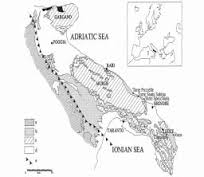Cryptokarst: A Case-Study of the Quaternary Landforms of Southern Apulia (Southern Italy)
DOI:
https://doi.org/10.3986/ac.v32i2.344Abstract
Skriti kras (cryptokarst) je kras, razvit pod prepustnim, vendar netopnim pokrovom. Nastane zaradi vode, ki prenika skozi krovne plasti. V krovnih plasteh se zbira voda, se poèasi preceja skoznje in razjeda matično kamnino. Zaradi tega nastanejo depresije, zapolnjene s pokrovnim sedimentom, in kraški stebri. Zaradi posedanja prepustnega pokrova, nastanejo na površju ulegnine. Če erozija odtsrani krovnino, se razgali relief, za katerega so značilni kraški stebri, razvalinasti relief in vrtače.
Cryptokarst is a karst developed beneath a permeable and not karstifiable formation by percolating waters. The permeable rock acts as a storage of water which feeds slow seepage and infiltration enhancing the alteration of bedrock. The resulting forms consist of depressions, filled by the covering sediments, and pinnacles. The sinking of the permeable cover can produce depressions on the topographic surface. Erosion of the cover exposes a landscape characterised by pinnacles, ruinforms and dolines. In the Apulia region, cryptocorrosion surfaces are characterized by solution pipes 4-5 meters deep and with variable width (from a few centimeters to about one meter). Pipes walls are covered by a brownish carbonate crust, from a centimeter to more than 10 centimeters thick. The continental sands are only found in these depressions. The cryptocorrosion process took place late in the Middle Pleistocene on Quaternary marine abrasion terraces covered by no-carbonate sandy-silty continental deposits. The process stopped before the Last Interglacial age in response of an abrupt climatic change that induces a calcium carbonate precipitation and the formation of a carbonate crust.
Downloads

Downloads
Published
How to Cite
Issue
Section
License
Authors guarantee that the work is their own original creation and does not infringe any statutory or common-law copyright or any proprietary right of any third party. In case of claims by third parties, authors commit their self to defend the interests of the publisher, and shall cover any potential costs.
More in: Submission chapter




